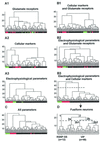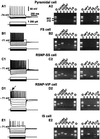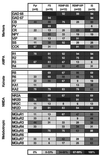Classification of fusiform neocortical interneurons based on unsupervised clustering
- PMID: 10823957
- PMCID: PMC18572
- DOI: 10.1073/pnas.97.11.6144
Classification of fusiform neocortical interneurons based on unsupervised clustering
Abstract
A classification of fusiform neocortical interneurons (n = 60) was performed with an unsupervised cluster analysis based on the comparison of multiple electrophysiological and molecular parameters studied by patch-clamp and single-cell multiplex reverse transcription-PCR in rat neocortical acute slices. The multiplex reverse transcription-PCR protocol was designed to detect simultaneously the expression of GAD65, GAD67, calbindin, parvalbumin, calretinin, neuropeptide Y, vasoactive intestinal peptide (VIP), somatostatin (SS), cholecystokinin, alpha-amino-3-hydroxy-5-methyl-4-isoxazolepropionic acid, kainate, N-methyl-d-aspartate, and metabotropic glutamate receptor subtypes. Three groups of fusiform interneurons with distinctive features were disclosed by the cluster analysis. The first type of fusiform neuron (n = 12), termed regular spiking nonpyramidal (RSNP)-SS cluster, was characterized by a firing pattern of RSNP cells and by a high occurrence of SS. The second type of fusiform neuron (n = 32), termed RSNP-VIP cluster, predominantly expressed VIP and also showed firing properties of RSNP neurons with accommodation profiles different from those of RSNP-SS cells. Finally, the last type of fusiform neuron (n = 16) contained a majority of irregular spiking-VIPergic neurons. In addition, the analysis of glutamate receptors revealed cell-type-specific expression profiles. This study shows that combinations of multiple independent criteria define distinct neocortical populations of interneurons potentially involved in specific functions.
Figures



References
-
- Houser C R, Hendry S H, Jones E G, Vaughn J E. J Neurocytol. 1983;12:617–638. - PubMed
-
- Ramón y Cajal S. General Structure of the Cerebral Cortex. 1995. trans. Swanson, N. & Swanson, R. W. (Oxford Univ. Press, New York), pp. 429–492.
-
- Celio M R. Science. 1986;231:995–997. - PubMed
-
- van Brederode J F, Helliesen M K, Hendrickson A E. Neuroscience. 1991;44:157–171. - PubMed
Publication types
MeSH terms
Substances
LinkOut - more resources
Full Text Sources
Other Literature Sources

